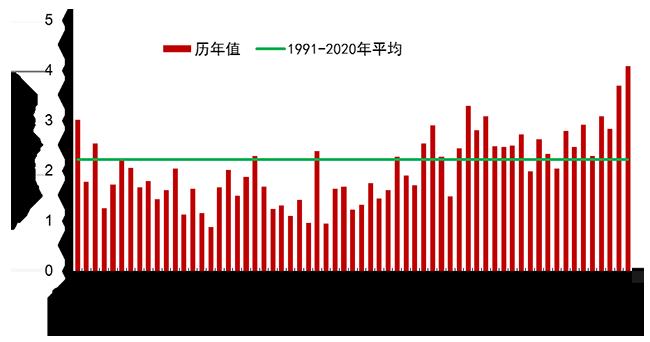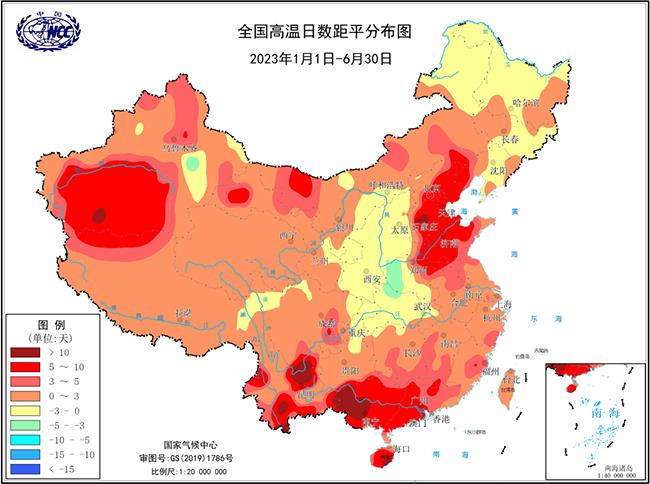National Climate Center: High temperature in Huanghuai, North China followed, and the number of high temperature days in China reached a record high.
Since the beginning of this year, the number of high temperature days in China has been the highest in the same period since 1961. There are four regional high temperature processes in China, which have the characteristics of early appearance, wide influence and remarkable extremes.
In June, the phenomenon of high temperature in North China and Huanghuai was the most prominent. The number of high temperature days in Beijing was the highest in the same period since 1961, followed by Hebei and Tianjin. The average temperature in June in Beijing-Tianjin-Hebei and Xinjiang provinces (autonomous regions and municipalities) was the highest in the same period in history.
The Central Meteorological Observatory predicts that there will still be many hot weather in eastern North China and northern Huanghuai in early July. Among them: 1-2 days, there will be obvious high temperature weather in North China, Huanghuai, Fenwei Plain and other places, and the highest temperature in some areas can reach 40 C. On May 5-8, there will be a continuous high temperature process in North China, Huanghuai and other places. In addition, on June 6-9, there was hot weather in the eastern part of the south of the Yangtze River and the eastern part of South China.
The National Climate Center predicts that in the midsummer (July-August) this year, there will be staged high temperature processes in North China, central and southern Central China, and northeastern southwest China.
Since the beginning of this year, the number of high temperature days in China has been the highest in the same period in history.
Since the beginning of this year (as of June 30th), the average number of days of high temperature (daily maximum temperature ≥35℃) in China is 4.1 days, 1.9 days more than the normal period (2.2 days), which is the highest in the historical period since 1961. Compared with the same period of normal years, the eastern part of North China, northern part of East China, western part of South China, southern part of Southwest China, southern Xinjiang and western Inner Mongolia are 5-10 days longer, and some areas are more than 10 days longer.

Annual Changes of National Average High Temperature Days from January 1 to June 30 (1961-2023)

Anomalous distribution map of high temperature days in China from January 1 to June 30, 2023
Since the beginning of this year, there have been four regional high temperature processes in China, from May 28th to June 5th, from June 6th to 12th, from June 14th to 17th and from June 21st to 30th. The daily maximum temperatures of 301 national meteorological stations in China have reached the standard of extreme events, and the daily maximum temperatures of 110 stations such as Qiaojia (44.4℃) and Yuanmou (43℃) in Yunnan, Tanghekou (41.8℃) in Beijing and Langfang (41.6℃) in Hebei have reached or exceeded historical extremes. From May 28th to June 5th, the first regional high temperature process occurred in China this year, 16 days earlier than normal, mainly affecting 15 provinces and cities such as Shanghai, Yunnan, Sichuan, Anhui and Guangdong.
Since June, the number of high temperature days in North China has been significantly higher, with extreme high temperatures frequently occurring in many places.
Since June (as of June 30th), the number of high temperature days in North China (Beijing-Tianjin-Hebei-Lu Yu, the same below) is 9.8 days, which is 5.2 days more than the normal period (4.6 days), and the fourth highest in the historical period since 1961. The number of high temperature days in Beijing (13.2 days) is the highest in the same period since 1961, followed by Hebei (12.2 days) and Tianjin (10.2 days) and Shandong (7.7 days).
Two regional high temperature processes on June 14-17 and June 21-30 mainly affected North China. On June 14-17, the highest temperature in 44 national stations in North China reached or exceeded 40℃, and the coverage area of high temperature above 35℃ reached 371,000 square kilometers, including 17,000 square kilometers above 40℃, affecting more than 200 million people.
On June 21-30, China experienced the fourth regional high temperature process this year, the strongest since this year. The high temperature in North China is extremely extreme, with 22 stations such as Tanghekou (41.8℃) in Beijing and Dagang (41.8℃) in Tianjin reaching or exceeding historical extremes, and 124 national stations exceeding 40℃. On 22-24, the temperature in the southern suburbs of Beijing reached or exceeded 40℃ for three consecutive days, and the high temperature in the urban area lasted for more than 40 hours. On the 22nd, the highest temperature in the southern suburbs of Beijing reached 41.1℃.
In the past 10 years (2014-2023), there have been 10 regional high temperature processes in North China. Except in 2014 and 2015, high temperature processes have occurred in North China every June in the past 10 years, but repeated high temperatures are rare in history. Judging from the comprehensive indicators, the comprehensive intensity of the high temperature process on June 21-30 this year was the strongest since this year, and the extreme was also the strongest in June in the past 10 years.
Huanghuai and other places in North China will also usher in many high temperature weather.
The Central Meteorological Observatory predicts that there will still be many hot weather in eastern North China and northern Huanghuai in early July. Among them: 1-2 days, there are obvious high temperature weather in North China, Huanghuai, Fenwei Plain and other places, and the highest temperature in some areas can reach 40 C. On May 5-8, there will be a continuous high temperature process in North China, Huanghuai and other places. In addition, on June 6-9, there was hot weather in the eastern part of the south of the Yangtze River and the eastern part of South China.
The National Climate Center predicts that in the midsummer (July-August) this year, the temperature in North China, the central and southern parts of Central China, and the northeastern part of Southwest China will be 1 ~ 2℃ higher than normal, and there will be a staged high temperature process.
(Editor: Bao Ning)